R
|
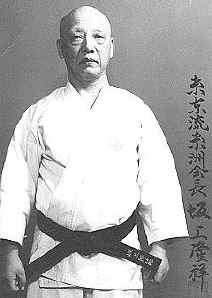
RYUSHO SAKAGAMI (1915 - 1993) was born in Hyogo Prefecture, Kawanishi City of Japan, the son of a very prosperous "Saki" (rice wine) family businessman. He began practicing the martial art of ‘KENDO" (way of Japanese Fencing) around the age of ten and in his later teen years began to study "IAIDO" (way of Samurai Sword Draw). Ryusho Sakagami continued to dilligently practice these arts and by 1934/35, he was enrolled at the prestigeous Tokyo University, the KOKUSHINKAN, who's specialty was producing the top KENDO instructors in Japan. While attending university, he became interested in the art to KARATE-DO and KOBUDO and later began to receive instruction from the famous Okinawan master, MODEN YABIKU.
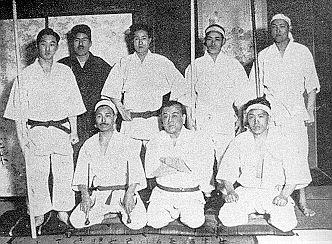
Shinken Taira (kneeling with
sai), Master Moden Yabiku (kneeling with crossed arms).
Over the next few years Ryusho Sakagami continued his education and intense training in various martial arts and around 1937, after repeated visits to Okinawa to train in Karate-do and
Kobudo, he was encouraged by some of the great masters to return to mainland Japan and continue his studies with the prominent Okinawan master KENWA MABUNI in Osaka.

Master Mabuni Kenwa
After graduating from university, Ryusho Sakagami returned to Osaka to become a dedicated disciple of Master
Mabuni. By 1941, he was successful in receiving the "SHIHAN" (master teacher) licence from Master Mabuni and a short while later returned to his home prefecture to establish the
"GEMBUKAN KARATE-DO DOJO".

(L-R): Sakagami Ryusho, Mabuni Kenwa (shaking hands),
Obata Isao,
Funakoshi Gichin (shaking
hands), Nakayama Matayoshi
As a result of his efforts to further promote the martial art to Karate-do, Ryusho Sakagami was awarded the honorary Karate-do title of
"RENSHI" (man of discipline) in 1942 from the DAI NIPPON BUTOKU-KAI, the most prestigeous martial arts organization in Japan at the time.A.Lange & Sohne Replica
Prior to the untimely death of Grandmaster Kenwa Mabuni on May 23 1952, Ryusho Sakagami Sensei was directed by the Grandmaster to accept the honorific position of "Third Generation Leader of
Itosu-ha" (Itosu's Orthodox Style) in early 1952.

Sakagami Sensei demonstrating Neko Ashi
After the Grandmaster's death, Sakagami Sensei moved to the Tokyo area where he taught for a short time in 1953, and then, finally settled in the town of Tsurumi located between the cities of Kawasaki and Yokohama.

Mrs. Sakagami
By 1955, Sakagami Sensei had firmly established the "ZEN NIPPON KARATE-DO ITOSU-KAI" headquarters for instruction in the martial arts of KENDO, KARATE-DO, KOBUDO, and JODO (way of the short-staff).

Itosu-kai Honbu , Tsurumi, Yokohama.
Over the next few years, Sakagami Sensei continued with the study of Ryukyu Kobudo under the direction of Grandmaster SHINKEN TAIRA who awarded him a Shihan licence in 1959, and later promoted him to the level of 8th Dan, Kobudo in 1963.

Master Shinken Taira
Master Sakagami's reputation as a highly qualified and well respected martial artist became legendary throughout Japan and around the globe.
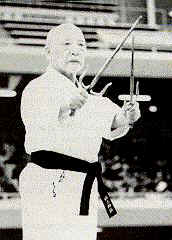
Sakagami Ryusho demonstrating Sai
By this period in time, he had also distingushed himself to a level of 5th Dan in AIKIDO, 5th Dan in JUDO, and 7th Dan in JUKENDO (way of Rifle & Bayonet). During 1962, Sakagami Sensei was greatly honored by being awarded the 7th Dan, KENDO - "KYOSHI" (man of high attainment) level of distinction.
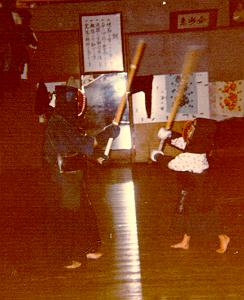

Sakagami Sensei and children's
class.
Besides serving as a director for the "Protection and Promotion of the Ancient Martial Arts of the Ryukyu Islands", Master Sakagami was one of the original "founding fathers" of the "Federation of All-Japan Karate-do Organizations" (F.A.J.K.O.) established in 1964 and proudly served as it's "chief technical judge" for many years. By 1977, he was again honored by receiving the 7th Dan, JODO - "KYOSHI" level of distinction.

Sadaaki Sakagami

Master Fumio Demura with
Sensei Sam Moledzki.

Seiko Suzuki
Among Master Sakagami's more notable disciples were his son Shihan SADAAKI SAKAGAMI (Chief Instructor, Japan Headquarters), Shihan SEIKO SUZUKI (Tokyo - founder of present SEIKO-KAI SHITO-RYU), Shihan FUMIO DEMURA (1965 founder of SHITO-RYU ITOSU-KAI, U.S.A.), and Shihan KEI C. TSUMURA (1969 Founder of SHITO-RYU ITOSU-KAI, CANADA).

K.C. Tsumura
In 1980, Master Sakagami was awarded the distinction of 8th Dan KARATE-DO -
"HANSHI" (Superior level of attainment) by F.A.J.K.O.and by 1987, he had also reached the 8th Dan IAIDO -
"HANSHI" level in the Muso Jikiden Eishin Ryu Iai system.
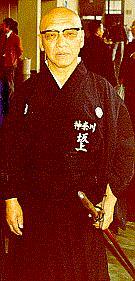
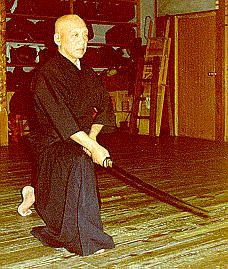
Sakagami Sensei practicing Iaido.
One of the final honors received by Master Sakagami was to be elevated to the 10th Dan KARATE-DO -
"HANSHI" (GRANDMASTER) level by the Nippon Karatedo Rengokai (Japan karatedo All-Styles Organization).

Grandmaster Ryusho Sakagami died of heart failure on Tuesday, December 28, 1993.
References/Bibliography
Sakagami Ryusho. Karate-do Taikan-Pinan. Tokyo, Japan: Kyusei Inc.,1974.
Sakagami Ryusho. Karate-do Taikan 39 Kata. Tokyo, Japan: Nichibo-Shuppansh, 1976.
Sakagami Ryusho. Nunchaku and Sai. Tokyo, Japan: Japan Publications, Inc.,1974.
Sakagami Ryusho. The Basic Formal Exercise of Nunchaku-Series I: Tokyo, Japan, 1969.
Sakagami Ryusho. Sai of Tsukenshitahaku-Series II: Tokyo, Japan, 1969.
Sakagami Ryusho. Tonfa of Hamahiga-Series III: Tokyo, Japan, 1972.
Finn Michael. Martial Arts, A Complete Illustrated History. London, Great Britain: Stanley Paul & Co. Ltd., 1988.
Japan Karate-do Itosu-kai Basic Training Booklet Vol-4, 1974.
Mc Carthy Pat/Batts Misao. Karate/Kung fu Illustrated Magazine . Burbank, California: Rainbow Productions, Inc., 1986.
American Karate Magazine, Article by John Therian. New York, NY: Condor Books Inc., Nov., 1989.
DeMarco Michael A. Journal of Asian Martial Arts. Erie, Pennsylvania: Via Media Publishing Co., 1994.
Moledzki Sam. Personal Data & Photograph Archives.